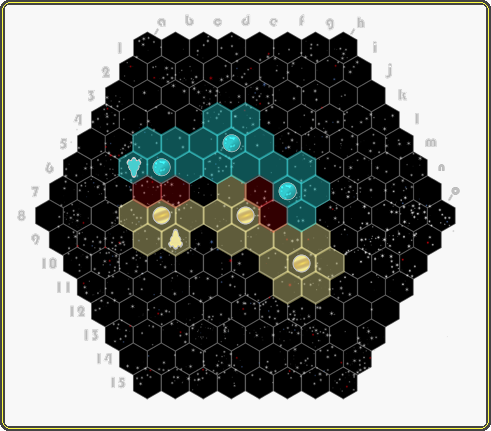Play Astralis interactively
Components
- A hex-hex-8 game board (or hex-hex-7 for shorter games)
- Two colony ship pawns, one yellow and one cyan
- Two sets of 30 planet stones (glass beads) in yellow and cyan
- One hundred sixty-nine double-sided control tiles with yellow on one side and cyan on the other
- Sixty contested tiles in red
 | Game Concepts
|
Set Up
Starting with the yellow player, each player places their pawn in any non-corner edge hex on their nearest edge of the board.
Game Play
Game play starts with the yellow player. Player turns alternate, no passing.
On a turn, a player must first move his or her pawn, then optionally place a stone. Following these action, the player must update control tiles affected by a stone placement. Players may receive one or more extra stone placements if certain conditions are met.
(Note: the MindSports app will update the tiles and create bonus stones automatically)
1) On a turn, a player must move his or her pawn one or more hexes, in any one of the six standard directions, to any hex not containing any stone or the opponent's pawn. Pawns may pass over any hexes not containing an opponent's stone or pawn. Pawns can pass over owned stones. Control tiles never impede movement and simply indicate ownership of a hex.
2) When a pawn reaches its destination hex, the player may (optional) place a control tile and an owned stone on top in any one of the empty hexes adjacent to the pawn that is not adjacent to any other stone.
3) For each hex adjacent to a placed stone, if the hex is not adjacent to any other stone, place a control tile own-side up in the hex; and if the hex has one or more adjacent opponent stones, replace the opponent’s control tile with a contested tile.
4) If after updating control tiles, a player has surrounded an empty hex or a hex containing the opponent's pawn that is not adjacent to any stones with owned controlled hexes, that player must immediately place an own-side-up control tile and a stone in the hex. If an opponent's pawn is present, the tile and stone are awarded when that pawn departs. Multiple bonus stones can be added in this way during a single turn.
5) If after updating control tiles, a player surrounds an opponent's stone with contested hexes, the active player must extract the opponent’s stone, flip its control tile and replace the stone with his or her own. Then, each formerly contested hex is reevaluated for its control or contested status. One or more bonus stones can be added in this way during a single turn.
Game End
The game ends when all hexes either contain a stone or are adjacent to a stone.
Winning the Game
To determine the winner, players count the number of control tiles they have on the board.
The second player (Cyan) adds a komi of 3.5 points to his total.
The player with the highest total wins.
(excerpt from the complete illustrated rules by the designer.)
Astralis © 2021, Phil Leduc
